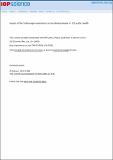| dc.contributor.author | Ashok, Akshay | |
| dc.contributor.author | Malina, Robert | |
| dc.contributor.author | Barrett, Steven R. H. | |
| dc.contributor.author | Speth, Raymond L. | |
| dc.contributor.author | Eastham, Sebastian D. | |
| dc.contributor.author | Dedoussi, Irene Constantina | |
| dc.contributor.author | Keith, David W. | |
| dc.date.accessioned | 2015-11-05T14:19:46Z | |
| dc.date.available | 2015-11-05T14:19:46Z | |
| dc.date.issued | 2015-10 | |
| dc.date.submitted | 2015-10 | |
| dc.identifier.issn | 1748-9326 | |
| dc.identifier.uri | http://hdl.handle.net/1721.1/99727 | |
| dc.description.abstract | The US Environmental Protection Agency (EPA) has alleged that Volkswagen Group of America (VW) violated the Clean Air Act (CAA) by developing and installing emissions control system 'defeat devices' (software) in model year 2009–2015 vehicles with 2.0 litre diesel engines. VW has admitted the inclusion of defeat devices. On-road emissions testing suggests that in-use NO[subscript x] emissions for these vehicles are a factor of 10 to 40 above the EPA standard. In this paper we quantify the human health impacts and associated costs of the excess emissions. We propagate uncertainties throughout the analysis. A distribution function for excess emissions is estimated based on available in-use NO[subscript x] emissions measurements. We then use vehicle sales data and the STEP vehicle fleet model to estimate vehicle distance traveled per year for the fleet. The excess NO[subscript x] emissions are allocated on a 50 km grid using an EPA estimate of the light duty diesel vehicle NO[subscript x] emissions distribution. We apply a GEOS-Chem adjoint-based rapid air pollution exposure model to produce estimates of particulate matter and ozone exposure due to the spatially resolved excess NO[subscript x] emissions. A set of concentration-response functions is applied to estimate mortality and morbidity outcomes. Integrated over the sales period (2008–2015) we estimate that the excess emissions will cause 59 (95% CI: 10 to 150) early deaths in the US. When monetizing premature mortality using EPA-recommended data, we find a social cost of ~$450m over the sales period. For the current fleet, we estimate that a return to compliance for all affected vehicles by the end of 2016 will avert ~130 early deaths and avoid ~$840m in social costs compared to a counterfactual case without recall. | en_US |
| dc.language.iso | en_US | |
| dc.publisher | IOP Publishing | en_US |
| dc.relation.isversionof | http://dx.doi.org/10.1088/1748-9326/10/11/114005 | en_US |
| dc.rights | Creative Commons Attribution | en_US |
| dc.rights.uri | http://creativecommons.org/licenses/by/3.0/ | en_US |
| dc.source | IOP | en_US |
| dc.title | Impact of the Volkswagen emissions control defeat device on US public health | en_US |
| dc.type | Article | en_US |
| dc.identifier.citation | Barrett, Steven R H, Raymond L Speth, Sebastian D Eastham, Irene C Dedoussi, Akshay Ashok, Robert Malina, and David W Keith. “Impact of the Volkswagen Emissions Control Defeat Device on US Public Health.” Environmental Research Letters 10, no. 11 (October 28, 2015): 114005. © 2015 IOP Publishing Ltd | en_US |
| dc.contributor.department | Massachusetts Institute of Technology. Department of Aeronautics and Astronautics | en_US |
| dc.contributor.mitauthor | Barrett, Steven R. H. | en_US |
| dc.contributor.mitauthor | Speth, Raymond L. | en_US |
| dc.contributor.mitauthor | Dedoussi, Irene Constantina | en_US |
| dc.contributor.mitauthor | Ashok, Akshay | en_US |
| dc.contributor.mitauthor | Malina, Robert | en_US |
| dc.relation.journal | Environmental Research Letters | en_US |
| dc.eprint.version | Final published version | en_US |
| dc.type.uri | http://purl.org/eprint/type/JournalArticle | en_US |
| eprint.status | http://purl.org/eprint/status/PeerReviewed | en_US |
| dspace.orderedauthors | Barrett, Steven R H; Speth, Raymond L; Eastham, Sebastian D; Dedoussi, Irene C; Ashok, Akshay; Malina, Robert; Keith, David W | en_US |
| dc.identifier.orcid | https://orcid.org/0000-0002-8966-9469 | |
| dc.identifier.orcid | https://orcid.org/0000-0002-7137-0637 | |
| dc.identifier.orcid | https://orcid.org/0000-0002-4642-9545 | |
| mit.license | PUBLISHER_CC | en_US |
| mit.metadata.status | Complete | |
